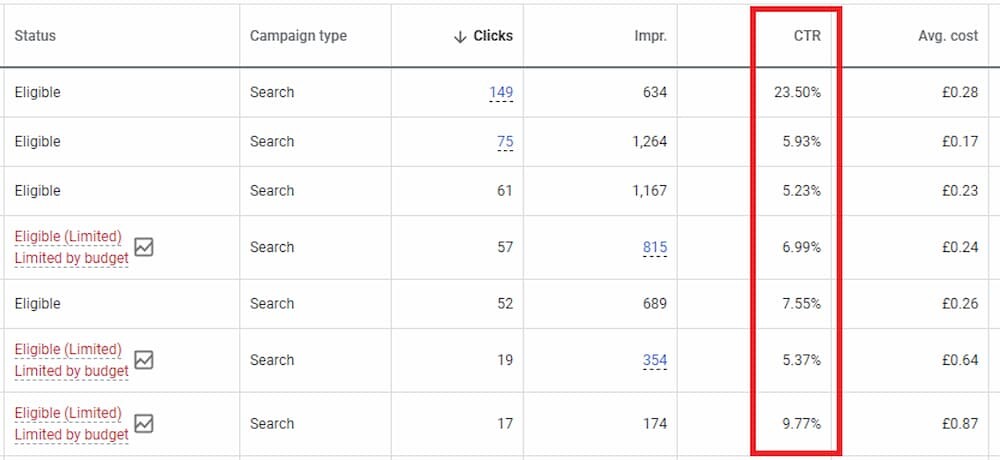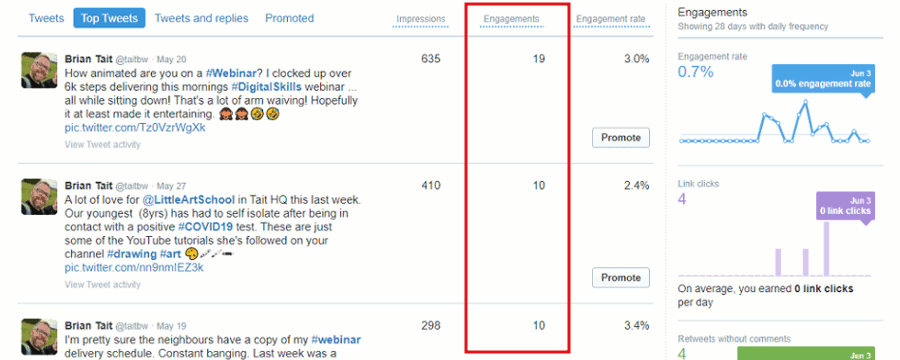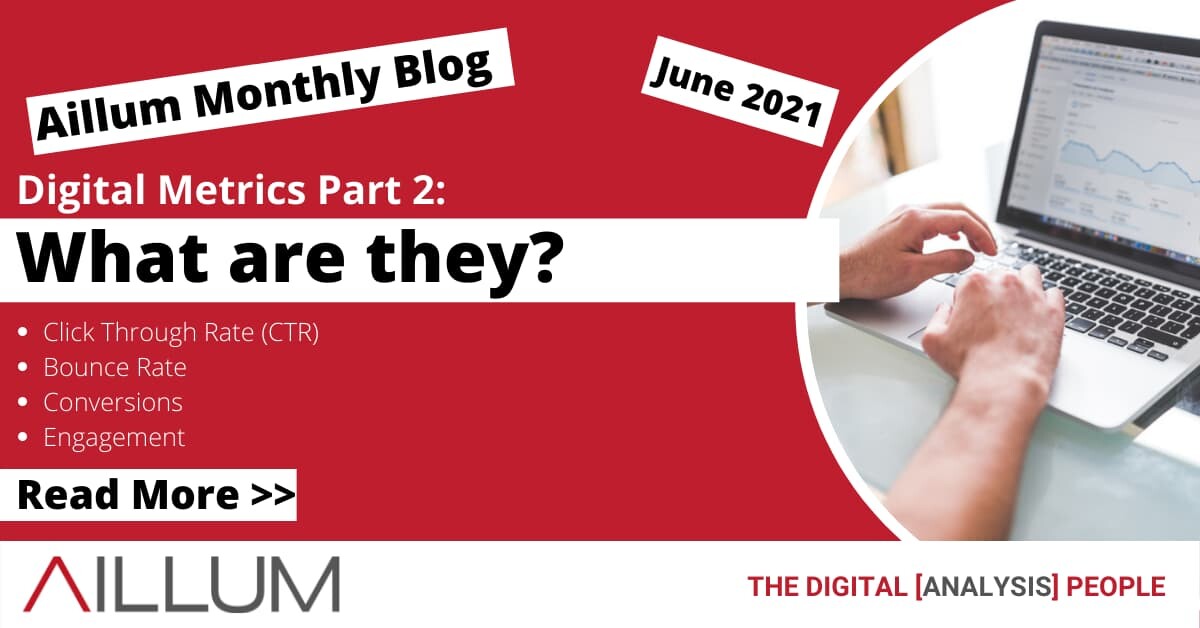Following on from Part 1 of our digital metrics blog, we are going to explain a few of the more metrics that are commonly used and how they can be useful for your business online. These metrics tend to be a bit more techy, but all the more reason to read ahead!
1. Click Through Rate
The engagement of your users is important, though as a metric it’s also quite in-depth and looks at many different factors. To get an idea of user engagement quickly, click through rate is a fantastic method of identifying what is working and what is not.
Click through rate (often abbreviated as CTR) is commonly used in various digital marketing campaign platforms. It’s calculated as a percentage of the number of clicks that have occurred from a number of impressions. As we mentioned in part 1, an impression is recorded when a user has your digital content shown to them. If the user decides to click that content to see or read more, then that click would be recorded as a click through. It should also be mentioned that clicks are synonymous with taps on mobile devices.
Some examples of click through rates that are useful in digital marketing are:
- Clicks on paid search or display ads, such as when using Google Ads
- Interacting with links within your emails to reach more of your content
- Tapping on a link within Facebook post to reach a page on your website
- Clicking on a link within a Twitter tweet
Bear in mind that a click through generally involves a user moving from one location to another online. This could be from a search engine results page through to your website, an email through to your blog, or a social post through to one of your product pages.

When it comes to email marketing in particular, if a user opens an email (which can be calculated as open rate) but doesn’t click on any of the content, that is not a click through!
How can you use the Click Through Rate Metric?
CTR is a great way to measure whether your content is encouraging clicks. If CTR is low, it suggests few people are clicking. That could be due to either poor content, or your content reaching the wrong audience. A first stage of using CTR would be to tweak how your content is displayed (wording, images, call-to-action text) to see if you can encourage more clicks.
Free Digital Tips Direct to your Inbox!
Be among the first to receive tips, advice and news on all things digital performance related. From new features in Google Analytics, Data Studio and other tools, to interesting articles, videos and more! Completely Free! (Unsubscribe any time you like!)
2. Bounce Rate
Mostly applied to web pages, bounce rate is a percentage that is calculated by the number of single-page sessions divided by the total number of sessions. A single-page session is when someone visits the website and only views a single page before leaving.
If a user lands on your site then leaves after just 1 page, they’re classed as having Bounced.
A high bounce rate can be good or bad, depending on the context. If the page is a landing page you use to get users on your website to browse products and services, a high bounce rate could indicate there’s a problem with that page. On the other hand, if that page is to deliver a specific piece of content and not retain any users, the bounce rate does not need to be low.
Unfortunately bounce rate itself cannot measure user engagement and this is one of the reasons Google Analytics 4 (the latest version of Google Analytics) is removing bounce rate as a metric and replacing it completely with engagement based metrics.
Unless you have a specific tracking setup, a user could perform a number of actions (download a PDF, play a video, click on a social button, etc) after landing on a page … but if they still only view 1 single page, they’ll still count as a bounce.
Check out our video on Google Analytics 4 and Bounce Rate for more information.
How can you use the Bounce Rate Metric?
Bounce rate is a good way to determine how well your website landing pages are performing. If bounce rate is high there may be an issue on the page that is causing visitors to leave. Your content may not be relevant to your target audience, there might be an annoying pop up that discourages people from staying or there might be a lack of calls-to-action to prompt visitors to stay. Bounce rates can show you at a glance how well a web page is received by your website visitors.
3. Conversions
When it comes to digital marketing, fewer metrics are more important than conversion rate. A conversion is when a user performs a desired action as a result of your digital marketing efforts online.
Conversions themselves can cover a broad variety of topics, as what you want from your digital efforts is unique to you, so here are a few examples:
- Setting up Goals in Google Analytics to watch for specific events
- Sign ups gained from an email newsletter
- Providing you feedback through a questionnaire pop up on your website
- Transactions from a sale that is advertised on your social media channels
- Users filling out a contact form to get in touch with you
- Interacting with a chatbot on your website to ask questions or gain information
The performance of conversions from specific marketing channels is measured as conversion rate. This is the percentage of conversions that occur from users who have been given the opportunity to convert.
How can you use the Conversion Rate Metric?
Conversion rate is a fantastic way to determine if your digital marketing campaigns are successful. A conversion is usually the last step of a customer journey and results in a tangible gain for your business. You can decide for yourself how to measure this. For example if you’re running a specific digital marketing campaign by email then you may want to consider users who just opened the email, or those who clicked through to your website from the email. Measuring conversion rates properly can show you just how much that campaign contributes to your business online.
4. Engagement
While the other metrics and measures we’ve discussed usually have tangible and defined values, such as numbers or percentages, Engagement is a little more complicated. Engagement is usually defined by when a user interacts with your website, email, or social media content in any way.
Measuring engagement can be done automatically at a basic level. If you want to measure engagement as accurately as possible, it’s vital that you set up effective campaign tracking. This might involve setting up UTM tracking, firing events on specific interactions, or setting up goals to track conversions. The more data that you can accurately track, the more accurate your knowledge of user engagement can be.

Google Analytics 4 uses engagement rate as a metric, by aggregating a few other criteria and considers a user as engaging if any of the following are true when they visit your website:
- Interacted with your website (in the foreground, being minimised or off-screen won’t count) for 10 seconds or more.
- A conversion event is fired, marking that a business objective was met on the page.
- The user records 2 or more page views, which is the current definition of “not bouncing”.
How can you use the Engagement Rate Metric?
Engagement rate is a key indicator of how often users perform meaningful actions with the content that you provide to them. This alone can help you decipher what types of content works and what does not, though it can also compliment other metric data. Using this along with other metrics and measurements, you’ll be able to determine exactly how much each digital marketing campaign contributes to your digital efforts online.





